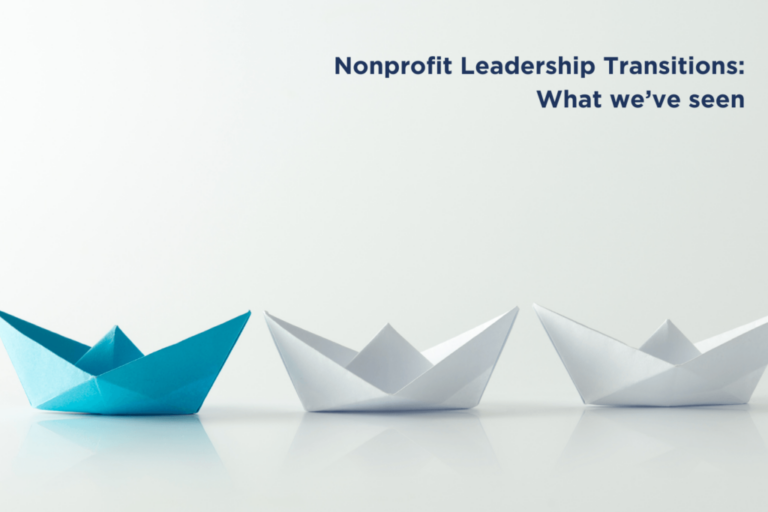Nonprofit Leadership Transitions, Part 2: What We’ve Seen

Before an organization can begin a transition in leadership, the board and staff need to understand what kind of transition they are facing. In the first post of this three-part series, Nonprofit Leadership Transitions, Part 1, we talked about the kinds of leadership transitions an organization may encounter and the important difference between a transition plan and a succession plan. It is important for the board and staff to have the time and personnel they need in place before they begin executing a transition whenever possible.
Propel team members have seen and experienced their share of leadership transition – as nonprofit staff, board members, and consultants. From these experiences we are sharing some potential upsides and challenges that come along to illuminate dynamics you can identify and navigate in your transition.
What we’ve seen – the upsides
Planning allows for laying the groundwork for a successful transition in both the short and long term. In these cases, we’ve seen thoughtful transitions that involve staff, strategic conversations, informed searches, and empowering onboarding. All change is disruptive, but in some cases you can also gain considerably. Consider the following:
- A leadership transition isn’t something a board does very often and when they do go through it, they flex a muscle they haven’t flexed before (aka board development). Board members can leave the transition process feeling more equipped and committed to govern the organization.
- Organizations that successfully navigate transitions feel prepared to continue to work together. They are refreshed on the organization’s purpose and strategic direction, and they are conditioned in their ability to move into the next phase together.
- A leadership transition can be a period of renewal. This can extend beyond the leadership and include renewed support from stakeholders. Whether it’s donors, board members, or partner organizations – your stakeholders are already invested and willing to help your organization meet its goals and thrive. A transition can be a point for further engagement.
- Timing is valuable. As a transition team, you will want to minimize the amount of time between your new leader arriving and adjusting and the departure of your exiting leader. This keeps momentum moving forward, relationships active, enthusiasm high, and attention focused on the future.
- Transitions are also a reflection of how your organization attends to its people and the culture. Welcome and introduce your new leader to the community and celebrate the contributions of the departing leader.
Potential challenges
Any transition can pose challenges. Here’s some common patterns we’ve noticed during transitions that are more disruptive than transformational:
- Swinging to a considerably different style of leadership as a reaction to the departing executive director without considering the strategic leadership needs of the organization.
- The board has not engaged in any preparation for a leadership transition, and its readiness to prepare, search, and onboard a new leader is lacking. “Winging it” or trying to learn it all as you go can lead to unnecessary mistakes.
- No onboarding process is in place. Board members are exhausted after preparing for and searching for a new leader, and then the new leader is left to onboard themselves.
- Not assessing the strengths and attributes of your current leader can lead to a loss of goodwill, intellectual capital, and relationship capital. Transferring and stewarding relationships during the transition and with the new leader is crucial.
- The longer a leader, or founder, has been in place, the steeper the learning curve for the incoming leader. A founder, long-term leader or charismatic leader may:
- Be underpaid compared to the current market. A new leader may request market-rate compensation.
- Have a strong personal following and be deeply identified with the organization because people in the sector know them and their accomplishments.
- Have achieved efficiencies in decision-making and problem solving, which have been built up over time, sometimes at the expense of board or staff involvement.
- New leaders who become the accidental “interim.” Try utilizing an interim executive director when appropriate to avoid this. For example, an interim can be effective when:
- A long-term leader leaves and restructuring needs to take place.
- There is organizational culture work to be done.
- The leadership transition happens suddenly. An interim can provide an extension of the preparation phase and be helpful in positioning the board and staff for the upcoming leader search and onboarding.
Let the work begin
Our final post will cover what it means to prepare for the search phase and how to support a new leader through a transition. Board members should expect there to be a 9-18 month learning curve for a new executive director. That learning curve will be influenced by the strategic conversations, board preparedness, and onboarding steps and team development that make up your transition process.
This blog is part of a three-part series by Mario Hernandez and Amanda Ziebell Mawanda. Subscribe to our newsletter to make sure you don’t miss part three.

